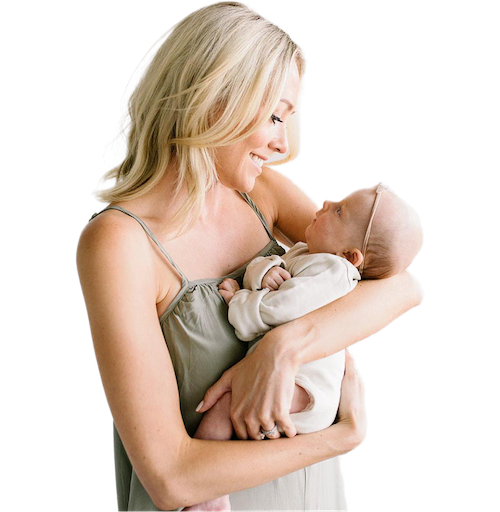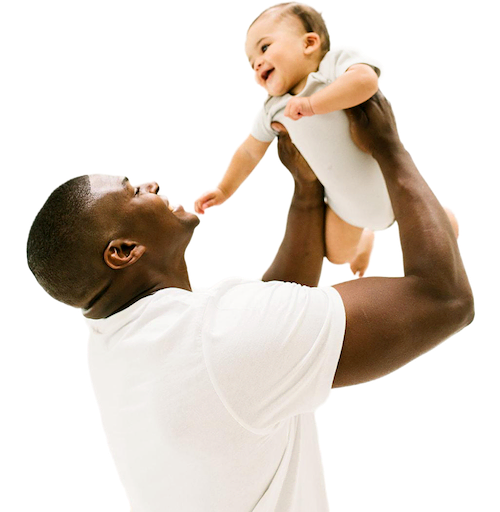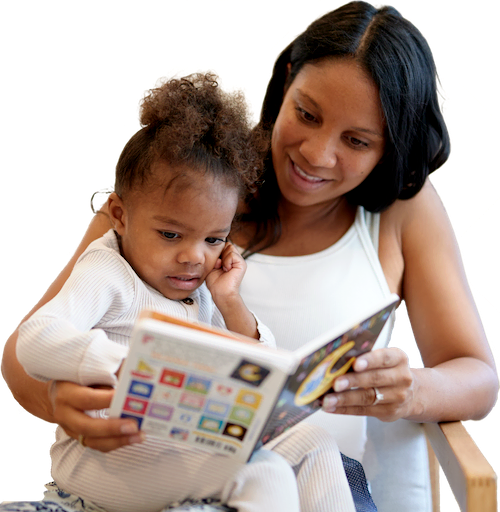Separation anxiety: when suddenly (or not so suddenly) your baby, toddler, or preschooler becomes nervous whenever they lose sight of you! If you’ve experienced it, you’ve likely noticed that separation anxiety can impact all aspects of your child’s life, including sleep.
Let me help!
Why do babies experience separation anxiety?anchor
Separation anxiety is a normal part of infant development.(3) Here are a few reasons that you may see separation anxiety surge:
Object permanence: Your little one’s brain is beginning to understand that when something goes out of sight, it still exists. Want to see it in action? Take a little toy or a Cheerio and place it under a cup. See what your little one does. Do they pick the cup up and look for it? That’s object permanence.
Stranger anxiety: Around 6-12 months, you may notice that your baby becomes clingy when they’re around people they don’t know or recognize. This can be especially evident when you have to hand them off to a new caregiver. Your baby may feel worried that their needs won’t be met if you or other familiar caregivers aren’t there to meet those needs.
Physical development: As your baby becomes more mobile and learns to crawl and move around, they may feel unsure since their new independence takes them away from you.
Please know that separation anxiety is a normal part of your child’s development and indicates secure attachment. I know it’s not fun, but it’s actually such a good sign!
What are signs of separation anxiety in babies?anchor
The most noticeable signs of separation anxiety in babies are increased clinginess and crying. This is true especially when you are initiating the separation – like when you put your baby down or when you leave the room. You may even see new or more frequent sleep struggles (like night wakings) from separation anxiety.
When does separation anxiety peak for babies? anchor
We often see the biggest surges between 8-10 months and again around 14-18 months. As with other developmental milestones, these are ranges and each baby develops at their own pace, so you may see signs of separation anxiety before or after these ranges.
What causes separation anxiety in toddlers or children?anchor
In older toddlers and preschoolers, we often see separation anxiety during times of big life changes (a new school, a new sibling, moving, potty training, moving to a toddler bed ) and during times of big developmental changes. You are your child's safe space, so when other parts of life feel unfamiliar, you may find that they cling to you for reassurance.
Your toddler or child also likely feels separation anxiety more deeply when it’s you leading the separation (like dropping off at daycare/preschool or leaving them with a babysitter or even putting them to bed), rather than when it’s on their terms. You’ll also find if your toddler is hungry, tired, or sick, their separation anxiety can become more difficult.
During moments of separation anxiety, your child may try to push boundaries as they figure out your responses to their behavior. This is all a normal part of your toddler’s development and a big reason it’s so important to remain consistent with how you respond.
What does separation anxiety look like in toddlers and preschoolers?anchor
Toddlers and preschoolers show many of the same signs as babies when experiencing separation anxiety. Here are some examples of what you may see (Remember: You can experience any of these signs at any age.):
Your 2 year old is becoming increasingly clingy and crying when separated from you or other caregivers.
Your 3 year old is having new or frequent sleep struggles, like protesting at bedtime.
Your 4 year old is hesitant around strangers or people they don’t know well.
Your toddler throws a tantrum any time you leave the room or house.
Since toddlers and preschoolers have more developed communication skills, tantrums are usually a more pronounced sign of separation anxiety for 2, 3, and 4 year olds.
Memory and imagination are also quickly expanding for your toddler or preschooler, which can trigger a fear of the dark.
When does separation anxiety peak for toddlers? Is it normal for a 3 year old to have separation anxiety? anchor
Around age 3, I often see a surge of separation anxiety for toddlers that tends to decrease as they get closer to 4 years old. Separation anxiety has peaks and valleys, so your independent toddler may seem just fine without you and then suddenly have days (or weeks) where they want you close by.
Can separation anxiety affect sleep? anchor
Yes, it can! When separation anxiety impacts sleep for your baby or toddler, it may look like this: (Remember: You can experience any of these signs at any age.)
Your baby cries when you enter the nursery.
Your 8 month old is fussier than usual and will only settle down for sleep if held.
Your 12 month old cries at nap/bedtime when being laid down or as you leave the room.
Your 18 month old is taking short naps or suddenly struggling to fall asleep at nap time.
Your 2 year old wakes in the middle of the night (and this wasn’t an issue before).
Your toddler is fighting bedtime.
Taking Cara Babies Classes
stars ( reviews)
If you need a step-by-step plan for working on sleep with your little one, even while you’re seeing separation anxiety, my classes can help. Choose your child's age to get started:
How can I help my baby, toddler, or preschooler deal with separation anxiety?anchor
1. Be intentional about 1-on-1 time.anchor
Have intentional 1-on-1 time with your child, even if it’s only 10-15 minutes. This extra attention and connection time can do wonders for helping your little one adjust to big transitions or changes.
2. Practice planned separation.anchor
You can start small by playing separation games. Playing peek-a-boo with your baby helps to reinforce that you come back and offers a fun way to explore object permanence. For toddlers and preschoolers, hide and seek can do the same thing. I recommend talking to your toddler while you are hiding to help them understand that you’re still close by, at least until they become more comfortable.
When you’re ready, have Grandma watch your little one while you run to the grocery store. Practicing separation can provide opportunities for your child to become comfortable for short times away from you and more secure in knowing you'll return.
3. Prepare for time apart. anchor
Talk to your child about what they can expect while you’re away so it doesn’t feel as unknown. Reading books is a great way to rehearse and prepare your little one for separation. If you have a baby, this may feel unnecessary, but it really can help! Even when your child doesn’t fully understand, narrating their experience in an age-appropriate way can help them feel safe and secure.
Expert Tip: When should you start talking about an upcoming separation? It depends on how long you’ll be away. Going for a quick Target run without your little one? Give them 20 minutes to warm up to the idea. Leaving for the evening? Talk about it a few times during the day. Heading away for a kid-free long weekend? You may need to prepare them a few days ahead of time.
4. Don’t sneak away.anchor
Let your child see you leaving. Sneaking away can sometimes increase a baby or toddler’s fear or anxiety around separation. Letting them see you leave promotes feelings of trust and offers an opportunity to keep supporting your baby or toddler as their brain understands this new concept.
Expert tip: When having a babysitter, you’ll want to plan a few minutes to allow your baby or toddler to warm up to their caregiver before you leave. It doesn’t need to be long, but just a bit of transitional time can help your child feel more secure after you leave.
5. Create a brief goodbye ritual.anchor
A hug, kiss, and “love you” is great. Remind them you always come back. This can help the goodbye feel more predictable and gives your baby or toddler a recognizable routine.
Once it’s time to leave, don’t linger: simply do your goodbye ritual and go. Going back and forth to give more kisses or offer more reassurance can become confusing and further upsetting for your baby or toddler.
Commit this to memory "Quick goodbyes lead to dry eyes."
6. Stay calm.anchor
Your little one will mirror your confidence. Your baby or toddler follows your cues to understand what is “okay” in the world. Staying calm helps to reassure your baby or toddler that this IS okay and that they can go right back to playing when they can’t see you. You can still acknowledge that this is hard for your baby or toddler. You could say something like, “I know this is hard, and you want me to stay. I have to go. I love you, and I’ll be back soon.”
7. Avoid being rushed.anchor
Provide some extra time in the morning to get ready for school or daycare so your little one doesn’t feel rushed, which can make a transition or separation more difficult. This also allows you to have time to manage your own emotions and follow through with your well-planned strategies.
Can a lovey or transitional object help with separation anxiety? anchor
Yes! A lovey or transitional object can provide comfort, ease feelings of anxiety, and help reduce sleep struggles (like short naps and night wakings). Research(1) has shown a comfort object can provide a sense of security during stressful transitions (like moving, traveling, illness, new environments, etc.).
Safety Tip: Lovies or transitional objects are NOT safe for sleep under 12 months.
When your baby or toddler is 12 months or older, you can introduce a lovey at nap and bedtime. Your child may not initially show any interest in the comfort object – and that’s okay! Sometimes it takes a bit for them to get used to the item. You can try:
Including the transitional object in your nap and bedtime routines
Snuggling the lovey between you and your toddler when feeding or reading books
Making the comfort object smell like you by holding it during the day or sleeping with it the night before introducing it to your little one
Letting your child pick out their comfort object
Expert Tip: Have 1 (or 2 or 3) identical backup lovies or comfort objects in case the current lovey needs a bath or gets misplaced. Alternate between the two so they maintain the same feel and appearance.
When can my baby sleep with a lovey? anchor
Lovies or transitional objects cannot be used for sleep when a baby is under 12 months. The AAP recommendations are that a baby’s sleep environment is bare (except for a fitted sheet) for the first 12 months.(2) This includes loose bedding, blankets, stuffed animals, comfort objects, and pillows.
You can introduce a lovey to your baby outside of the crib before they turn 1 (but remember, this is only for awake time). When choosing a comfort object, make sure it’s soft (you don’t want your child waking up or hurting themselves when rolling on it at night) and avoid anything that has loose parts or is a choking hazard (like button eyes).
If you have any concerns about introducing a transitional object, consult with your pediatrician.
Need more safe sleep tips? Check out my Safe Sleep Checklist.
How do I help with separation anxiety around sleep?anchor
Here are a few of my best tips for handling separation anxiety around bedtime and nap time:
1. Maintain your bedtime routine.anchor
Just like with the goodbye routine, keeping consistent with your bedtime routine helps your baby (5-24 months) or toddler (2-4 years) prepare for separation. A familiar routine provides security and will help this stage pass quickly.
Want a free printable toddler bedtime routine chart?
This downloadable chart includes BONUS tips on how to implement a visual bedtime routine with your toddler.
2. Spend time in your child’s bedroom.anchor
If you see separation anxiety at bedtime or nap time or your little one cries when you enter the nursery, be sure to spend time in your child’s room during awake time. Get dressed there, change diapers, or play with toys! These fun activities and positive experiences will increase their comfort in the room, which makes it easier when you have to leave.
3. Don’t add any new habits.anchor
Changing things up may appear to make it easier in the short term, but any new tactics may become struggles you have to deal with long term. This is how a developmental stride turns into a full-blown sleep regression. Consistency with your sleep approach provides safe and secure boundaries around sleep for your little one, even when you're seeing signs of separation anxiety.
4. Have a plan.anchor
If bedtime and naps are always a struggle or you need help getting back on track with sleep, my classes will give you a plan to achieve restful and independent sleep, whether you have a baby (5-24 months) or a toddler (2-4 years old).
Separation Anxiety FAQanchor
-
Separation anxiety can happen anytime from 4 months to 4 years or older. We often see the biggest surges between 8-10 months, 14-18 months, and again around 3 years old.
-
You are your child’s main source of comfort and security. When your child is growing, transitioning, or experiencing big changes, they cling to you to provide that support.
-
You can! Loveys and comfort objects can be a great help during surges of separation anxiety. Just be sure to wait until your child is at least 12 months old before allowing a lovey or comfort object in the crib.
-
Provide a secure base for your child by staying calm, practicing planned separation, and talking about it in an age-appropriate way. Check out the rest of the blog for more specifics that apply to your little one.
References
5 Sources
Triebenbacher and Tegano. (1993). Children’s Use of Transitional Objects during Daily Separations from Significant Caregivers
American Academy of Pediatrics. (2022). Sleep-Related Infant Deaths: Updated 2022 Recommendations for Reducing Infant Deaths in the Sleep Environment
Stone et. al. (2015). Relations Between Parental and Child Separation Anxiety: The Role of Dependency-Oriented Psychological Control
A.D.A.M. Medical Encyclopedia. MedlinePlus. (2022). Separation anxiety in children.
Healthy Children, American Academy of Pediatrics. (2022). Separation anxiety and sleeping.
Keep in mind that the information and content on this blog is for informational purposes and should not be considered medical advice. If you have questions about your child, please reach out to your doctor.












